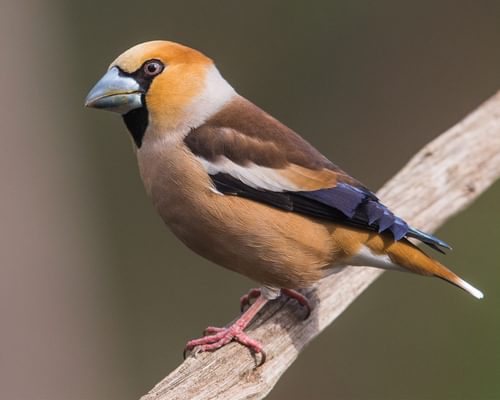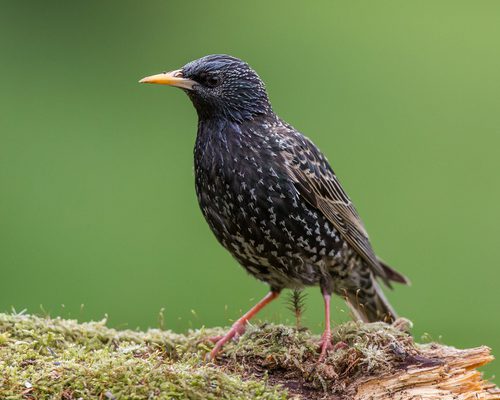Bohemian Waxwing
Least ConcernBombycilla garrulus
Visual Identification
Appearance
The Bohemian Waxwing is a sleek, medium-sized bird with a distinctive crest and silky-smooth plumage. Its body is primarily soft grey, transitioning to cinnamon-brown on the head and under the tail. The wings are slate grey with striking white and yellow markings.
Adults have a black mask and throat, contrasting with a subtle yellow-tipped tail. The namesake waxy red tips on the wing feathers are more pronounced in older birds.
Females are similar to males, although they have fewer waxy wingtips. Females also have a narrower yellow band at the tail tip and a smaller, less clearly defined black chin patch. Juveniles lack these waxy tips and have a more muted overall coloration.
Size
Length
19cm to 23cm
Wingspan
32cm to 35cm
Weight
55g to 80g
Colours
Males and females have similar plumage
Primary Colour
Grey Brown
Secondary Colour
Black White Yellow Red
Beak Colour
Black
Leg Colour
Black
Habitat and Distribution
Habitats
Woodland
Garden
Wetland
Coastal
Urban
Farmland
Grassland
Desert
Tundra
Rainforest
Mountain
Savanna
Distribution
Bohemian Waxwings breed in the boreal forests of North America and Eurasia, favoring open woodlands with a mix of deciduous and coniferous trees. During winter, they move southward in search of food, often appearing in urban areas and parklands.
In North America, they are winter visitors to the northern United States and southern Canada. In Europe, they can be seen in the UK and other parts of northern and central Europe during irruption years, when food scarcity drives them further south than usual.
Elevation Range
Up to 2,000 meters
Climate zones
Subarctic, Temperate
Distribution Map
This map gives you a rough idea of where you might spot a Bohemian Waxwing. The coloured areas show countries where these birds have been seen.
A few things to keep in mind:
- Birds might not be everywhere in the coloured areas, for example, they may be present around the coast of that country
- Where birds live can change with seasons and available food
- This map is quite simple - it doesn't show exact locations
We're working on making our maps even better! Soon, we hope to show you:
- More detailed maps for bigger countries, including state and region
- How birds move around during different seasons
Distribution by Region
Behaviour and Ecology
Bird Attributes
This feature is in beta. We'd love your feedback to improve it!
Share your thoughtsBird Attributes Explained
Our bird attributes system rates various aspects of a bird's capabilities on a scale of 0-100, based on data from field observations, scientific studies, and expert knowledge.
Attribute Categories:
- Agility: Manoeuvrability, speed, and grace in flight or movement.
- Strength: Physical power, often correlating with size and hunting abilities.
- Adaptability: Ability to thrive in various environments or changing conditions.
- Aggressiveness: Territorial behaviour and assertiveness, particularly during breeding seasons.
- Endurance: Stamina, often seen in migration patterns or foraging behaviours.
Understanding the Ratings:
- 0-20: Very Low
- 21-40: Low
- 41-60: Average
- 61-80: High
- 81-100: Very High
Remember, these attributes are relative to other bird species and don't necessarily indicate superiority.
Hover over the icon next to each attribute for more information.
Tap the icon next to each attribute for more information.
Agility
Reflects the bird's manoeuvrability, speed, and grace in flight or movement.
The Bohemian Waxwing demonstrates considerable agility in flight, particularly when manoeuvring in flocks and foraging for berries. Their ability to pass food from bird to bird in mid-air also suggests good coordination and dexterity.
Strength
Indicates the bird's physical power, often correlating with size and hunting abilities.
As a medium-sized bird weighing between 55-80 grams, the Bohemian Waxwing has moderate strength. While capable of long-distance flights during irruptive migrations, they are not known for particularly powerful physical feats.
Adaptability
Represents the bird's ability to thrive in various environments or changing conditions.
Bohemian Waxwings show high adaptability, thriving in both boreal forests and urban environments. Their nomadic lifestyle and ability to switch between various fruit sources, including fermented berries, demonstrate significant ecological flexibility.
Aggressiveness
Measures the bird's territorial behaviour and assertiveness, particularly during breeding seasons.
These birds are notably non-aggressive, often seen in large, sociable flocks. Their courtship behaviour involves gentle interactions like mutual preening and food sharing, rather than aggressive displays.
Endurance
Reflects the bird's stamina, often seen in migration patterns or foraging behaviours.
Bohemian Waxwings exhibit good endurance, particularly during their irruptive migrations and when foraging. Their ability to consume up to three times their body weight in fruit daily suggests a robust metabolism suited for sustained activity.
Diet
Bohemian Waxwings are primarily frugivorous, with a strong preference for berries, especially rowan and juniper. They supplement their diet with insects during the breeding season. Flowers, tree sap, and other plant matter are eaten in small amounts.
Their ability to metabolize alcohol allows them to consume fermented fruits that other birds avoid, though this can occasionally lead to intoxication.
Behaviour
Bohemian Waxwings are highly social, often seen in large, nomadic flocks that descend on fruit-bearing trees. They exhibit a unique behavior of passing berries from bird to bird in a line before eating.
During courtship, pairs may hop towards each other, touching bills and exchanging small items like flower petals.
Vocalisation
Bohemian Waxwings are known for their high-pitched, thin, sighing trill, often described as 'sirrrrr'. This call is frequently heard as flocks move between feeding sites.
During courtship, males produce a series of low, buzzing notes. Their calls are subtle but distinctive, often the first sign of their presence.
Nesting & Breeding
Breeding occurs in late spring to early summer, with pairs forming shortly after arriving at breeding grounds. Courtship involves males presenting food to females and mutual preening.
Nests are built primarily by females, typically in coniferous trees. They are cup-shaped structures made of twigs, grass, and moss, lined with feathers. Females lay 3-5 pale blue eggs with dark spots.
Incubation lasts about 14 days, and it is primarily done by the female. Both parents feed the nestlings, which fledge after about 14-16 days. Young birds may remain with their parents in flocks through their first winter.
Lifespan
The Bohemian Waxwing typically lives for 5 years, with a maximum recorded lifespan of 13.5 years.
Like all birds, lifespan can be affected by factors including predation, habitat quality, disease, and access to food sources.
Conservation and Status
Global Conservation Status
While currently listed as Least Concern, Bohemian Waxwings face threats from habitat loss and climate change. Their reliance on specific fruit-bearing trees makes them vulnerable to changes in vegetation patterns.
Conservation efforts focus on preserving boreal forest habitats and maintaining urban green spaces with suitable food sources.
Birdwatching Tips
- Look for large flocks in winter, especially near fruit-bearing trees or shrubs
- Listen for their high-pitched, trilling calls, which often announce their presence
- Observe urban parks and gardens, where they may visit to feed on ornamental fruit trees
- In North America, check areas with mountain ash or crabapple trees during irruption years
Additional Information
Quick Facts
Other names:
Waxwing
Family:
BombycillidaePredators
Main predators include raptors such as Sharp-shinned Hawks, Cooper's Hawks, and Merlins. Small mammals like squirrels may prey on eggs and nestlings.
Did You Know?
- Bohemian Waxwings can eat up to three times their weight in fruit in a day.
- Their name 'Bohemian' refers to their nomadic lifestyle, not their geographic origin.
- The waxy red tips on their wings are actually flattened extensions of the feather shaft.
Was this bird profile helpful?
Your feedback helps us improve our content
Thanks for your feedback!
Your input helps us improve our content.
Community Experience
Community Ratings
No ratings yet - be the first to rate this bird!
Latest Community Reviews
No reviews yet
Sign in to be the first to review
Community Reviews
Create Your Free Account Welcome Back!
Join our community to rate birds and share your experiences. Creating an account is completely free and only takes a minute. Sign in to your account to rate birds and share your experiences with our community.
Your information is secure and will never be shared.
By creating an account, you agree to our Privacy Policy.
FAQs
What does a Bohemian Waxwing symbolize?
For some, the Bohemian Waxwing represents the arrival of winter, while for others, these nomadic birds may symbolize a free spirit that travels in search of nourishment or fulfillment.
Why are they called Waxwings?
Waxwings are named for the waxy tips on their secondary feathers, visible as red spots on their folded wings. Just why these birds develop waxy wingtips is something of a mystery, although they may be useful for impressing a mate.
Similar Birds
References
- 2 3
website: BirdLife International. 2016. Bombycilla garrulus. The IUCN Red List of Threatened Species 2016: e.T22708146A87399543.
View source - 4
report, 2015: EBCC
- 1
website, 2010: Fransson et al., EURING list of longevity records for European birds
View source

